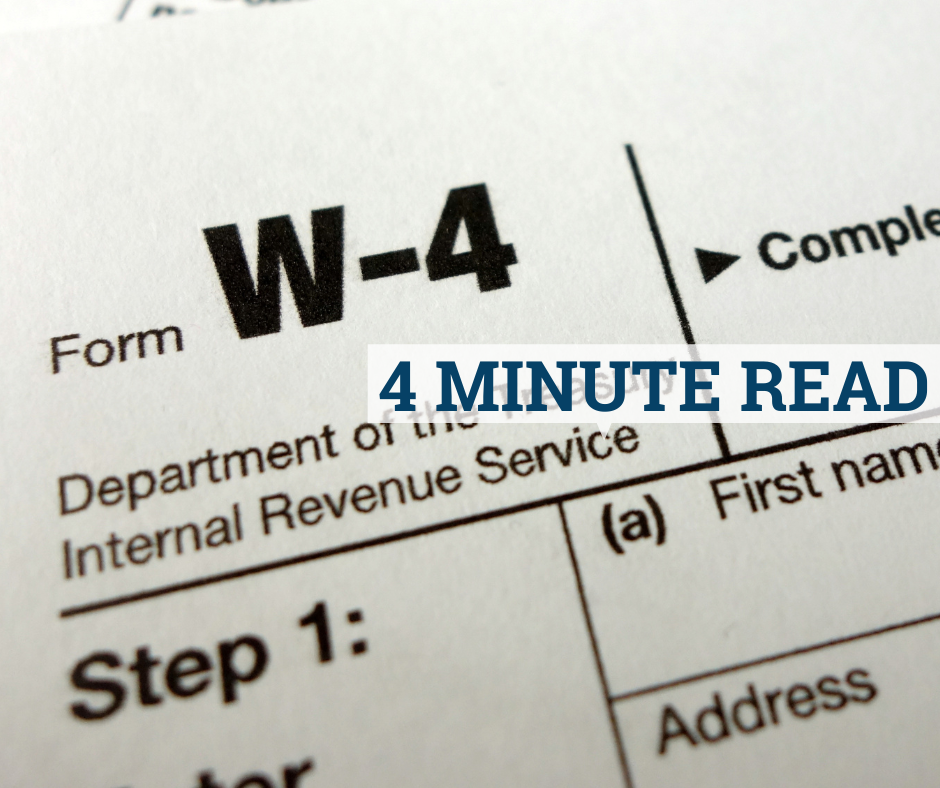
Each year, the Internal Revenue Service (IRS) releases revised forms to help individuals and businesses correctly handle federal income tax withholding. For 2025, the IRS has published updated versions of:
- Form W-4: Employee’s withholding certificate
- Form W-4P: Withholding certificate for periodic pension or annuity payments
- Form W-4R: Withholding certificate for nonperiodic payments and eligible rollover distributions
Below is an overview of each form, how they differ, and what employers should keep in mind.
Form W-4: For Employees’ Wage Withholding
Who uses it: Active employees earning wages or salaries.
Purpose:
- Informs an employer how much federal income tax to withhold from each paycheck.
- Reflects an employee’s filing status, multiple jobs, dependents, and any additional withholding amount.
2025 updates/reminders:
- There is a minor tip reminding employees about the IRS tax withholding estimator.
- The “Multiple Jobs Worksheet” (on page 3) includes updated wage thresholds for 2025.
- Employees who haven’t adjusted their withholding since 2019 are encouraged to submit a fresh W-4 to help ensure accurate tax withholding.
Employer tip:
- Prompt employees to review their Form W-4 annually or whenever significant life changes occur (e.g., marriage, divorce, birth of a child).
Form W-4P: For Periodic Pension Or Annuity Payments
Who uses it: Individuals receiving periodic (regularly scheduled) pension or annuity distributions (e.g., monthly retirement benefits).
Purpose
- Tells the pension or annuity payer (often a plan administrator) how much federal income tax to withhold from each periodic payment.
- Mirrors many of the W-4 adjustments but specifically pertains to retirement income streams rather than employee wages.
2025 updates/reminders:
- No major changes from the prior year, but the new form includes references to using the IRS’s tax withholding estimator (particularly beneficial for partial-year or more complex retirement scenarios).
- Starting in 2023, payees had to switch to the “redesigned” W-4P or W-4R. This continues in 2025, so ensure retirees/pensioners are using the correct new version.
Employer (or Plan Administrator) tip:
- Clarify for retirees that Form W-4P only applies to periodic pension or annuity distributions. For one-time or lump-sum retirement distributions, see Form W-4R.
Form W-4R: For Nonperiodic Payments And Rollovers
Who uses it: Individuals receiving nonperiodic distributions or eligible rollover distributions from qualified retirement plans, IRAs, annuities, etc.
Purpose:
- Governs how much federal income tax is withheld from lump sums or other nonperiodic distributions, including rollover distributions (those not being paid out on a recurring schedule).
- Often associated with a flat percentage approach.
2025 updates/reminders:
- Also lightly updated for 2025, with references to the IRS tax withholding estimator for more precise calculations.
- For many nonperiodic payments, the withholding default rate may be 10% or 20% (depending on the distribution type), unless the payee specifies a different arrangement on Form W-4R.
Employer (or Plan Administrator) tip:
- If your business or plan pays out one-time distributions, ensure recipients understand that Form W-4R must be submitted if they wish to adjust from the default withholding percentages.
Differences At A Glance
|
Form |
Primary User |
Payment Type |
Key Notes |
|
W-4 |
Employees with wages |
Regular wages/salaries |
Employees give this to their employers to set paycheck withholding |
|
W-4P |
Retirees receiving pensions |
Periodic annuity/pension |
Payees file with the plan administrator for ongoing retirement payments |
|
W-4R |
Recipients of nonperiodic/lump sums |
One-time distributions |
Covers distributions such as lump-sum or rollover from retirement plans |
Tips For Employers
- Educate your workforce
- Provide guidance on which form is relevant. For instance, employees actively working for you submit W-4; retirees collecting monthly pension checks submit W-4P.
- Stay current on IRS changes
- Reference Publication 15-T (2025) and the latest IRS instructions.
- The IRS encourages using the tax withholding estimator, so share this resource link with employees/retirees.
- Encourage updates after major life events
- Marriage, divorce, or adopting a child may warrant a new Form W-4 or W-4P to ensure proper withholding.
- Distinguish between periodic and nonperiodic
- Periodic = Repeated payments on a set schedule (W-4P).
- Nonperiodic = One-time or lump-sum distribution (W-4R).
- Use reliable collection processes:
- Keep digital or paper records consistent, and ensure new forms are collected whenever employees or payees want to change withholding amounts.
Conclusion
Navigating the IRS’s 2025 updates for Forms W-4, W-4P, and W-4R is crucial to maintaining accurate tax withholding for both wages and retirement distributions. Familiarize yourself with the specific scenarios each form addresses, encourage your employees and retirees to review their withholding decisions, and utilize the IRS’s online tools for best results.
Even when you have a good understanding of each payroll form, the time and effort it takes to complete them and manage your payroll can put a serious dent in your schedule. That’s why many owners turn to Group Management Services (GMS) to handle payroll administration for their small business. Our experts take an active approach to managing your payroll so that you can spend your time growing your business instead of struggling with forms and tax calculations.
Need assistance managing withholdings or other payroll processes? Get in touch with GMS today to see how we can support you with a streamlined, comprehensive payroll solution.